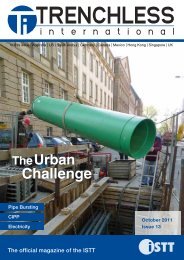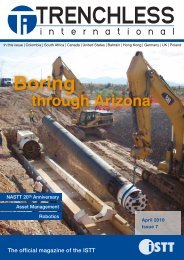North American Special - Trenchless International
North American Special - Trenchless International
North American Special - Trenchless International
You also want an ePaper? Increase the reach of your titles
YUMPU automatically turns print PDFs into web optimized ePapers that Google loves.
Locating laterals in Toronto<br />
Benko Sewer Services of Ontario uses four IBAK Lateral Launch Systems (LISY) in order to maintain<br />
essential services in the city of Toronto, Canada.<br />
A guide to manual<br />
coating application<br />
products anD services<br />
April 2009 - <strong>Trenchless</strong> <strong>International</strong><br />
Benko, a division of Badger Daylighting, is a multi-disciplinary<br />
company that specialises in CCTV inspections, maintenance and<br />
flushing\cleaning of sewers, catch basin cleaning, smoke and<br />
air testing, and hydro-excavating. For the past 15 years, Benko<br />
has serviced and supported customers from all regions of<br />
Ontario. Benko uses only industry leading products from the most<br />
respected manufacturers in the world today, offering diverse<br />
applications to meet the needs of both private and municipal<br />
clients.<br />
The IBAK - LISY lateral launch system was introduced in 1993.<br />
The first of its kind, the LISY has evolved throughout the years<br />
and still provides users with unparalleled control, capability and<br />
picture quality.<br />
Over the past year, the company has increased its existing<br />
fleet of CCTV trucks by acquiring four IBAK lateral launch units<br />
to complement and maintain essential wastewater services. The<br />
trucks have been used to carry out lateral launch contracts in<br />
both the municipal and private sectors and have to date pushed<br />
over three thousand lateral launches as well as increasing the<br />
capacity for regular mainline contracts.<br />
Benko has had great success with these units in respect to<br />
productivity, reliability and quality of the end product. The picture<br />
quality is constantly noticed by clients and maintains a consistently<br />
high quality in any pipe size. The operating platform for the<br />
CCTV operators is quite different from the rest of the fleet, but<br />
training has been of minimal effort due to the user-friendly nature<br />
of the control system.<br />
The company focuses on quality equipment, such as the<br />
Badger Hydrovac units, and sees this as being the key to achieving<br />
success in the industry. The company believes that IBAK has<br />
been the equivalent on the CCTV side of the business and has<br />
given the ability to mix high quality equipment with high quality<br />
operators to achieve a superior service.<br />
Benko has been employed on a contract within the city of<br />
Toronto, which requires locating the depth and line of the sewer<br />
connections up to the building line. The advantage of this method<br />
is that there is no intrusion to residential property (in order to<br />
remove toilets) to achieve the same location results. The main<br />
contract being carried out at present is lateral locating using the<br />
IBAK - LISY. The trucks are pushing lateral launches every day.<br />
A Benko spokesperson said “we have faced many different<br />
scenarios with the condition, line, material of the pipe, but the<br />
IBAK Lisy has been consistent in giving us the results we are<br />
looking for. One area in particular would be where there is a<br />
‘Y’connection within the sewer lateral.<br />
“We are able to push both ways through the ‘Y’ by using the<br />
pan and tilt motion and the guide rod to direct us into each line<br />
as required.”<br />
The spokesperson said another key advantage with the system<br />
has been the capability of carrying out a manline ‘manhole<br />
to manhole’ run and to seamlessly carry out required lateral<br />
launches along the line using the same camera and data collection<br />
software without the need to produce separate video files<br />
and reports.<br />
A truck with IBAK - LISY on board.<br />
RapidView IBAK <strong>North</strong> America distributes IBAK products through a dealer network in the United States,<br />
Canada and the Caribbean Islands.<br />
The rehabilitation of pipes damaged by corrosion has resulted in the creation of innovative and<br />
effective solutions. The following provides a ‘how to’ guide for the manual application of mortar<br />
coatings.<br />
The coating of drinking water pipes has been offered<br />
within Germany since 1970. Cement mortar coatings, as per<br />
DWGW W 343, DIN 2880, DIN 2614 and EN 805, are carried<br />
out in situ on pipes from DN 80 diameter upwards. The centrifugal<br />
spray technique is a clear favourite application method.<br />
Sewer pipes have been coated with mortar in Germany since<br />
1982. The applications methods are:<br />
1. Manually applied coating<br />
2. Wet spray coating<br />
3. Centrifugal spray coating<br />
4. Displacement process<br />
Shafts and other installations in the German public drainage<br />
system have also been coated with mortars since 1982.<br />
Manually applied and wet spray coatings were the predominant<br />
methods, however the centrifugal spray M-coating<br />
process has gained more popularity recently.<br />
Manual Coating<br />
Equipment:<br />
Mortar mixing container, bucket, two-paddle mixer, trowel,<br />
steel float, sponge board, coarse sponge, graduated water<br />
container, brush or soft broom<br />
Applying the bond layer:<br />
The first step is to create a bond layer using the renovation<br />
mortar. The grout needs to be mixed to a consistency between<br />
soft and plastic and then brushed onto the prepared substrate.<br />
The bond layer should be approximately 1-2 mm thick. If the<br />
substrate shows signs of damage or cavities, these must be<br />
filled in with mortar.<br />
Mixing the pipe renovation mortar:<br />
The appropriate ERGELIT-KS mortars are mixed according<br />
to their particular instruction sheet. Always take care to<br />
put the water into the mixing receptacle first. The amount of<br />
water, calculated as a percentage in relation to the dry weight<br />
of the mortar must be exact in order to guarantee the desired<br />
water-solid ratio of 0.4 or less. The water-solid ratio is usually<br />
provided as this is more practical for mixing dry mortars on<br />
site. It is also extremely important to mix the mortar for the<br />
recommended time.<br />
Coating:<br />
The mortar coating is applied by trowel and float, wet-onwet,<br />
to the bond layer applied previously. Using the trowel to<br />
apply the mortar, as is done with ordinary cement mortars, is<br />
difficult in this case because of the high adhesion factor and<br />
is not advisable. However, there are often occasions when<br />
technically there is no alternative. As a rule, several wet-on-wet<br />
applications are required depending on the depth desired.<br />
It is essential that the surface be lightly roughened between<br />
coats with a sponge or sponge board to ensure the application<br />
of the next coat. The surface of the final coat is smoothed with<br />
a damp brush in order to prevent water and air becoming<br />
trapped during the final steel coat smoothing.<br />
When repairing damage caused by biogenic sulphuric acid,<br />
if using ERGELIT-KS 2b as coating mortar, the fresh mortar’s<br />
high thixotropy must be taken into account. This means that<br />
the fresh mortar will stiffen in the mixing container after about<br />
5-10 minutes if mixing is interrupted. If this occurs, the mortar<br />
can be re-mixed for 20-30 minutes to recover its original consistency.<br />
In order to speed up the setting time, some mortars can be<br />
modified by the use of compatible accelerators, however the<br />
manufacturer should be consulted.<br />
Ambient temperature influences working time and must<br />
be observed. Working times for the different mortars can<br />
be obtained from technical data sheets available from the<br />
manufacturer. As manual coating has little impact energy, it is<br />
generally considered to be a top surface coating technique.<br />
In the past manual coating was the most popular technique.<br />
In the future it is anticipated that the wet-spray technique will<br />
be used for larger and irregularly shaped installations.<br />
products and services<br />
April 2009 - <strong>Trenchless</strong> <strong>International</strong><br />
34<br />
35
















